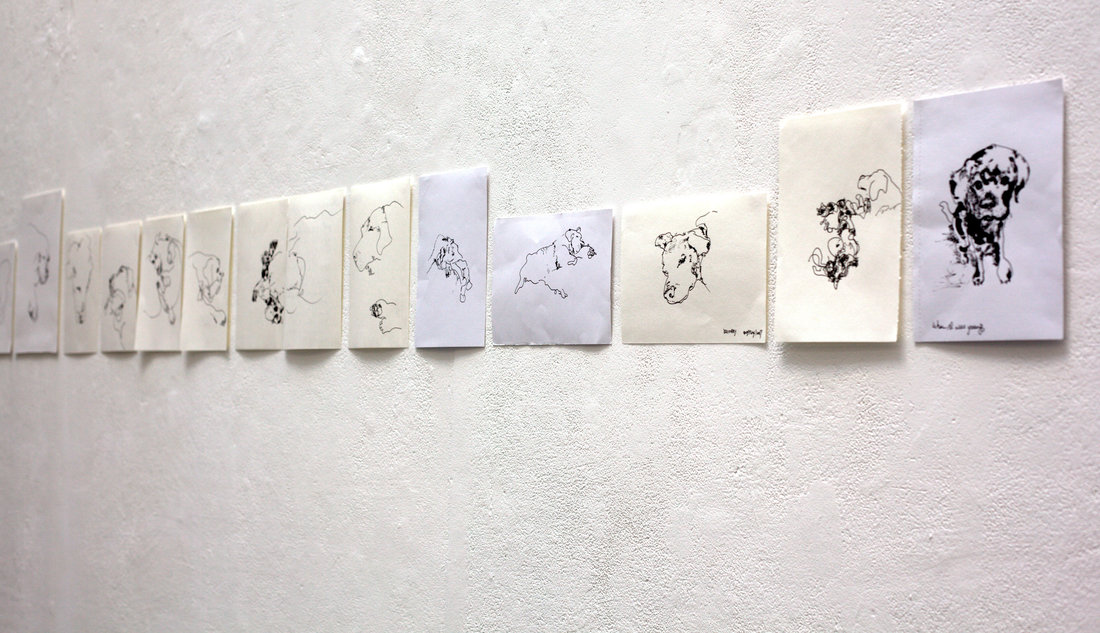VR tour -mobile Exhibition View 2017 ( scroll down for desktop version)
"Making art allows me to make sense of the world and myself."--Shizico Yi
Shizico Yi's work aims to explore artistic obsession through repetitive documentation of the domestic and the everyday. Yi uses photography, large-scale installations, moving image projections, and two-dimensional visual images (paintings, drawings, and prints) to articulate her relationship to family and memories.
This exhibition, Loss, Repetition and the Everyday 2017, presents a collection of drawings and large-scale 3D installations telling stories of an imaginative world that is inspired by her real life; the installations bring viewers into their own imaginative space to connect with their own life experiences. (the exhibition is accompanied by her essay for Prof. Doctorate in Fine Art)
The most significant resource for Yi's works is her life experience and the culture clash of the east-meets-west. She takes inspiration from her culture, background, memories, and a traumatised childhood. Art practice allows her to bring new energy to the burden of memories and to deal with loss. Although the content of her work seems personal, the loss is a universal human experience. Yi believes artists' ultimate responsibility is to reveal universal truths through exploring their lives and experiences.
When asked why did audiences have to be made to suffer through the three hours of his film Andrei Rublev (1966), Tarkovsky wrote in his diary :
'It's because the twentieth century has been the rise of a kind of emotional inflation….there are some artists who do make us feel the true measure of things. It is a burden which they carry throughout their lives, and we must be thankful to them.' (Tarkovsky, 1994: 9, entry 1st Sep 1970)
Many artists are obsessive in their way, for instance: Kusama's obsession with self- obliteration, Tarkovsky's obsession with his childhood memories, Hatoum's obsession with exploring the conflicts and contradictions of our world, On Kawara's obsession with the four decades in which he made Date Paintings. Shizico Yi's obsession might be to find the order in day-to-day living, to seal memories by documenting mundane moments, and ultimately to leave traces of her own existence.
During her Doctorate years, Yi created a series of large-scale installations which project moving images onto sculptural surfaces and natural objects. The projected videos are developed from Yi's documentary photos and video footage archive. She experiments with time-lapse, stop-motion, one-shot cameras, and long-period documentary films in these film projects.
For her two-dimensional works, Yi creates a series of diptych and polytypic paintings, which develop from her 'date paintings' and drawings.
Besides the studio practice, Shizico Yi is also working on a not-for-profit art project to curate exhibitions and publish art magazines to feature and support independent artists. During these Professional Doctorate years, her curatorial project helped numerous UEL colleagues alongside 140 artists around the world to exhibit in professional galleries in central London. She continues this professional practice throughout her career, along with studio practice.
Shizico Yi's work aims to explore artistic obsession through repetitive documentation of the domestic and the everyday. Yi uses photography, large-scale installations, moving image projections, and two-dimensional visual images (paintings, drawings, and prints) to articulate her relationship to family and memories.
This exhibition, Loss, Repetition and the Everyday 2017, presents a collection of drawings and large-scale 3D installations telling stories of an imaginative world that is inspired by her real life; the installations bring viewers into their own imaginative space to connect with their own life experiences. (the exhibition is accompanied by her essay for Prof. Doctorate in Fine Art)
The most significant resource for Yi's works is her life experience and the culture clash of the east-meets-west. She takes inspiration from her culture, background, memories, and a traumatised childhood. Art practice allows her to bring new energy to the burden of memories and to deal with loss. Although the content of her work seems personal, the loss is a universal human experience. Yi believes artists' ultimate responsibility is to reveal universal truths through exploring their lives and experiences.
When asked why did audiences have to be made to suffer through the three hours of his film Andrei Rublev (1966), Tarkovsky wrote in his diary :
'It's because the twentieth century has been the rise of a kind of emotional inflation….there are some artists who do make us feel the true measure of things. It is a burden which they carry throughout their lives, and we must be thankful to them.' (Tarkovsky, 1994: 9, entry 1st Sep 1970)
Many artists are obsessive in their way, for instance: Kusama's obsession with self- obliteration, Tarkovsky's obsession with his childhood memories, Hatoum's obsession with exploring the conflicts and contradictions of our world, On Kawara's obsession with the four decades in which he made Date Paintings. Shizico Yi's obsession might be to find the order in day-to-day living, to seal memories by documenting mundane moments, and ultimately to leave traces of her own existence.
During her Doctorate years, Yi created a series of large-scale installations which project moving images onto sculptural surfaces and natural objects. The projected videos are developed from Yi's documentary photos and video footage archive. She experiments with time-lapse, stop-motion, one-shot cameras, and long-period documentary films in these film projects.
For her two-dimensional works, Yi creates a series of diptych and polytypic paintings, which develop from her 'date paintings' and drawings.
Besides the studio practice, Shizico Yi is also working on a not-for-profit art project to curate exhibitions and publish art magazines to feature and support independent artists. During these Professional Doctorate years, her curatorial project helped numerous UEL colleagues alongside 140 artists around the world to exhibit in professional galleries in central London. She continues this professional practice throughout her career, along with studio practice.

